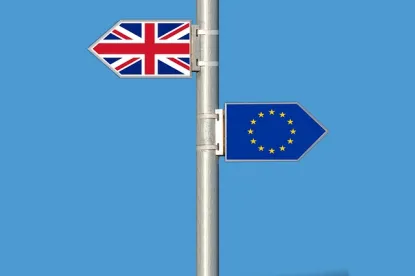This post is the first in an on-going series of articles on the implications to the automotive industry of the June 23, 2016 referendum decision in the United Kingdom (“UK”) to exit the European Union (“EU”). This first article will reprise briefly developments leading to the Brexit vote, the process that now appears likely to unfold and the implications as the UK changes its relationship with the EU. Suffice to say, there has long been growing political, social, cultural and economic restiveness in the UK about EU policies, rules and membership obligations culminating in the vote to “leave” (despite a more than 20 year battle leading to the UK’s joining the EU in 1973).
While the majority vote to leave was very, very narrow and while many voters explained their vote to “exit” as simply “sending a message” of their generalized dissatisfaction with the status quo, the message has been received with significant and widely-reported fall out. The consequences are already being felt across the board exemplified by the plunging value of the UK pound, the uncertain future of non-UK EU nationals working in Britain or through the decisions (whether fundamental, incremental, explicit or unknowing) being made as each day since the Brexit vote passes by business to change strategies and priorities. All these consequences will have costs, whether for better or worse.
Executive Summary
Assuming that the UK does not suddenly wake up from what has becomingly widely viewed as a very bad dream, the near term problem/challenge in the UK and in the EU as a whole is uncertainty. The UK and the EU must, like it or not, negotiate the UK’s terms of exit and of its future relationship with the EU pursuant to the increasingly famous Article 50 of the 2009 Treaty of Lisbon. Until the “exit,” the UK will remain a member and, theoretically, benefit from and be subject to all of the elements of its current EU member status. However, for example, even if regulatory structures (e.g., direct application of EU law in the UK, competition policy, tariffs/trade and free movement of goods), social policies (e.g. free movement of people) and frameworks in negotiation (e.g., the unitary patent system) remain in place for the present there will be, at a minimum, increasing divergence as people, enterprises and countries adjust their respective strategies to the new reality. Whatever the outcome of the exit negotiations and what form the new relationship between the EU and the UK may take (e.g., the so-called Norway or European Economic Area (“EEA”) model in which some (but not all) of existing benefits/obligations would remain the same, there are likely to be many changes in the relationship, some with consequences that the UK will have to endure for its newly-gained “independence.”
This exit negotiation will not be short and sweet.
It will likely be characterized by increased bitterness, frustration, cynicism and self-interest. If not “death by a thousand cuts,” the outcome for the EU, for the UK and for their international partners will almost surely be less stable, less efficient, more costly and less secure in overall political, economic and security terms.
The Historical Context: “Four Freedoms,” Shared Destinies and Increased Integration
Before assessing what lies ahead, it is useful to step back and remember a few basic principles. The EU evolved directly from the ashes of two great wars in the 20th century in which millions of combatants were killed and literally tens of millions of people were liquidated. These two wars had roots in countless centuries of war, conflict, suspicion, prejudice and isolation (political, economic and cultural).
Starting in 1951, a treaty known as the European Coal and Steel Treaty was signed by 6 previously warring countries (France, Germany, Italy, Belgium, the Netherlands and Luxembourg). The preamble to the treaty made clear that the signatory nations that resolved:
-
To substitute for age old rivalries the merging of essential interests;
-
To create, by establishing an economic community, the bases for a broader and deeper community among peoples long divided by bloody conflict; and
-
To lay the foundation for institutions which will give direction to a destiny henceforth shared.
Following from that beginning based on those shared aspirations, there followed the European Atomic Energy Treaty in 1957, the European Economic Treaty in the same year (the “Rome Treaty”), the Single European Act in 1986, the Treaty on European Union in 1993, the Treaty of Amsterdam, the Treaty of Nice and the Treaty of Lisbon most recently in 2009.
The Rome Treaty sought to assign some tasks to the emerging community. Article 2 of the Rome Treaty states that, by establishing a common market and progressively approximating the economic policies of the members states, the Community will promote: 1) harmonious development of economic activities; 2) a continuous and balanced membership expansion; 3) an increase in stability; 4) an accelerated raising of the standard of living; and 5) closer relations between member states.
To achieve these goals, Article 3 of the Treaty directs that the activities of the community shall include:
-
The elimination as between member states of custom duties and quantitative restrictions on the import and export of goods and all measures having equivalent effect;
-
The establishment of a common customs tariff and a common commercial policy towards third countries;
-
Institution of a system ensuring that competition in the common market is not distorted; and
-
The approximation of laws of the member states to the extent required for the proper functioning of the common market.
That process of integration enshrined four so-called essential “freedoms:” the free movement of people, goods, services and capital. These “four freedoms” produced a community of almost 500 million people who have now lived for over 75 years in peace with their neighbors and who have witnessed the development of one of the world’s most vibrant economies that sprang from the ashes of bombed and decimated communities. It is against this historic background that the June 23 Brexit decision must be judged.
It should be evident that the majority of UK voters favoring Brexit rejected, at least implicitly, many of the founding principles on which the EU was based – harmonization of laws across an ever-increasingly level economic playing field, freedom of business and people to move across national boundaries and, most profoundly, the notion that Europeans shared a common destiny.
Competition Policy
While it may seem that competition policy is not necessarily the most important priority in focusing on Brexit, common competition policy was at the core of the impetus for the creation of the European Community and ultimately the European Union. It does as well highlight some added layers of complexity, uncertainty and cost that lie ahead as the UK exits the EU. Depending on the outcome of the Brexit negotiations, there are a number of issues to consider:
-
At the heart of the European merger control is the European Merger Control Regulation (“EMCR”). As a regulation, it has direct effect throughout the EU and confers exclusive jurisdiction on the European Commission to investigate and prohibit anticompetitive mergers, acquisitions and concentrative joint ventures that had a “community dimension.” The EMCR provided for “one-stop” shopping that made merger control in Europe more efficient, less costly and more uniform. Brexit may, depending on the negotiated terms of the exit, reduce the utility or availability of the one-stop shop. The current EMCR provides a mechanism for the European Commission to take jurisdiction over deals not having a community dimension under certain stated circumstances. UK exit may diminish the value of this provision and will likely result in parallel proceedings in the UK and the EU.
-
This same kind of problem arises with respect to international cartel enforcement. Here, there is a significant risk of dual prosecution of the same alleged illegal activity, the possibility of multiple fines and penalties being imposed and the risk of inconsistent outcomes in these parallel proceedings. In addition, there are serious questions of procedure and policy. It is unclear how investigations will be conducted, documents, and information collected, confidentiality protected, etc. Open questions relate to the potential conflicting criminal and civil regimes, lenience and “lenience plus” as well as the potential erosion of the protections of the attorney-client privilege. International cartel enforcement cooperation will need a reset as well.
-
There is likely to be at least short-term uncertainty on private damage actions. There has been a long effort in the EU to promote an effective system of private (and collective) redress for antitrust injury. While by no means like the U.S. model of class action treble damages and attorney fees (which is widely rejected as excessive in Europe), there has been substantial progress to develop an EU model which would be applicable in all 28 EU member states. To that end, the EU has adopted a “directive,” which would establish greater uniformity on provisions applicable in actions for private redress. Among the many provisions of the directive are rules regarding limitations periods, the binding nature of EU decisions on infringements, etc. Under EU rules, this EU damage directive must be adopted as a part of the internal legislation by each member state by December, 2016. Given the UK exit from the EU, it is unclear whether and when the directive will be adopted in the UK. This will add further uncertainty and complexity to the already difficult challenges faced by private plaintiffs.
-
Finally, the UK exit may result in EU legislative changes to the competition policies to move away from the market-centric, consumer welfare premises which have been important in the development of EU law and which the UK had a central role in fostering.
Our future articles will provide updated reports on the status of the exit negotiations and the ramifications in important areas such as international trade, export controls, intellectual property, data privacy and government contracts. Stay tuned…







 />i
/>i

